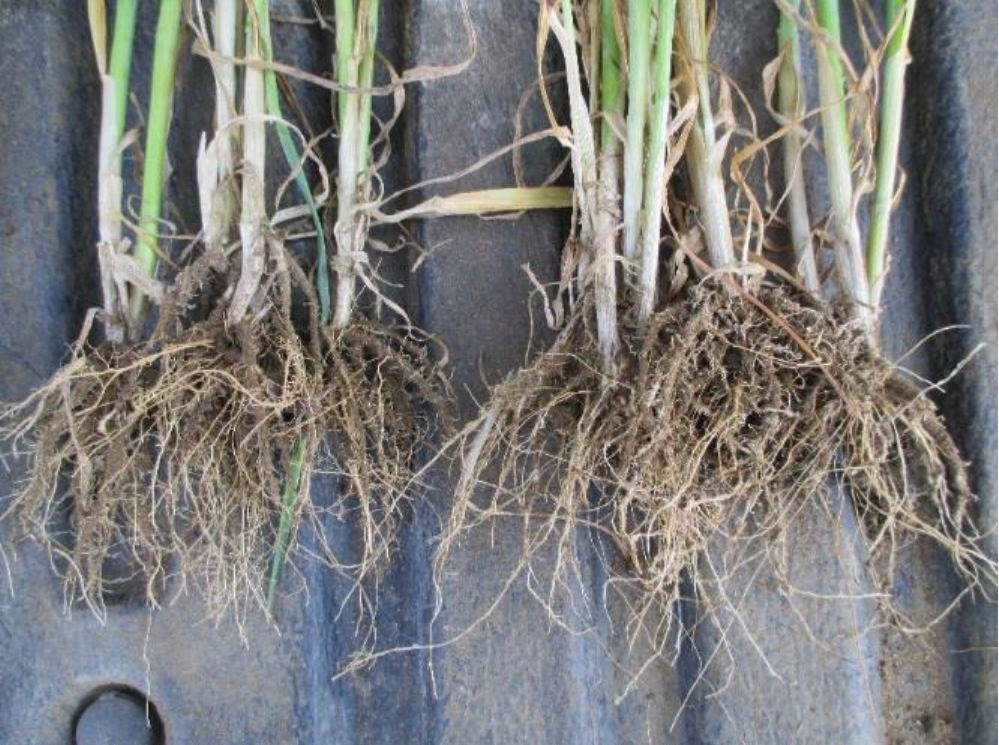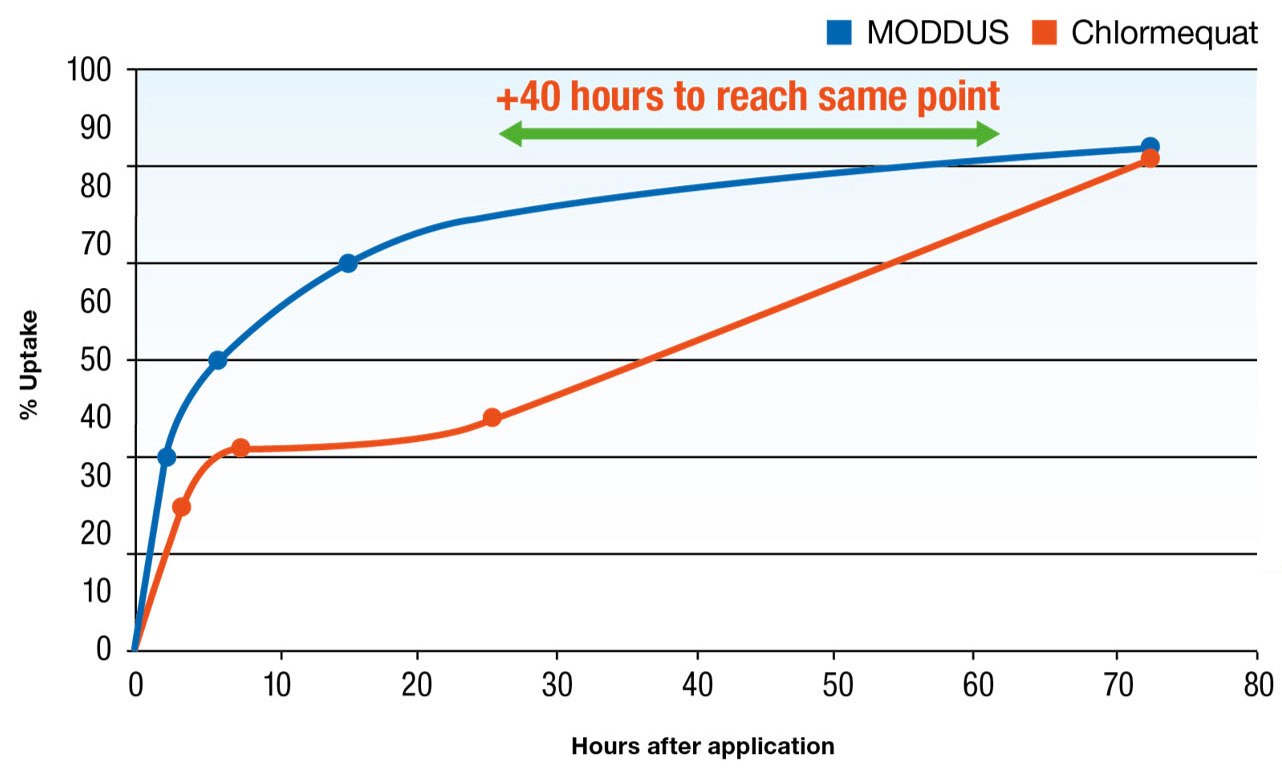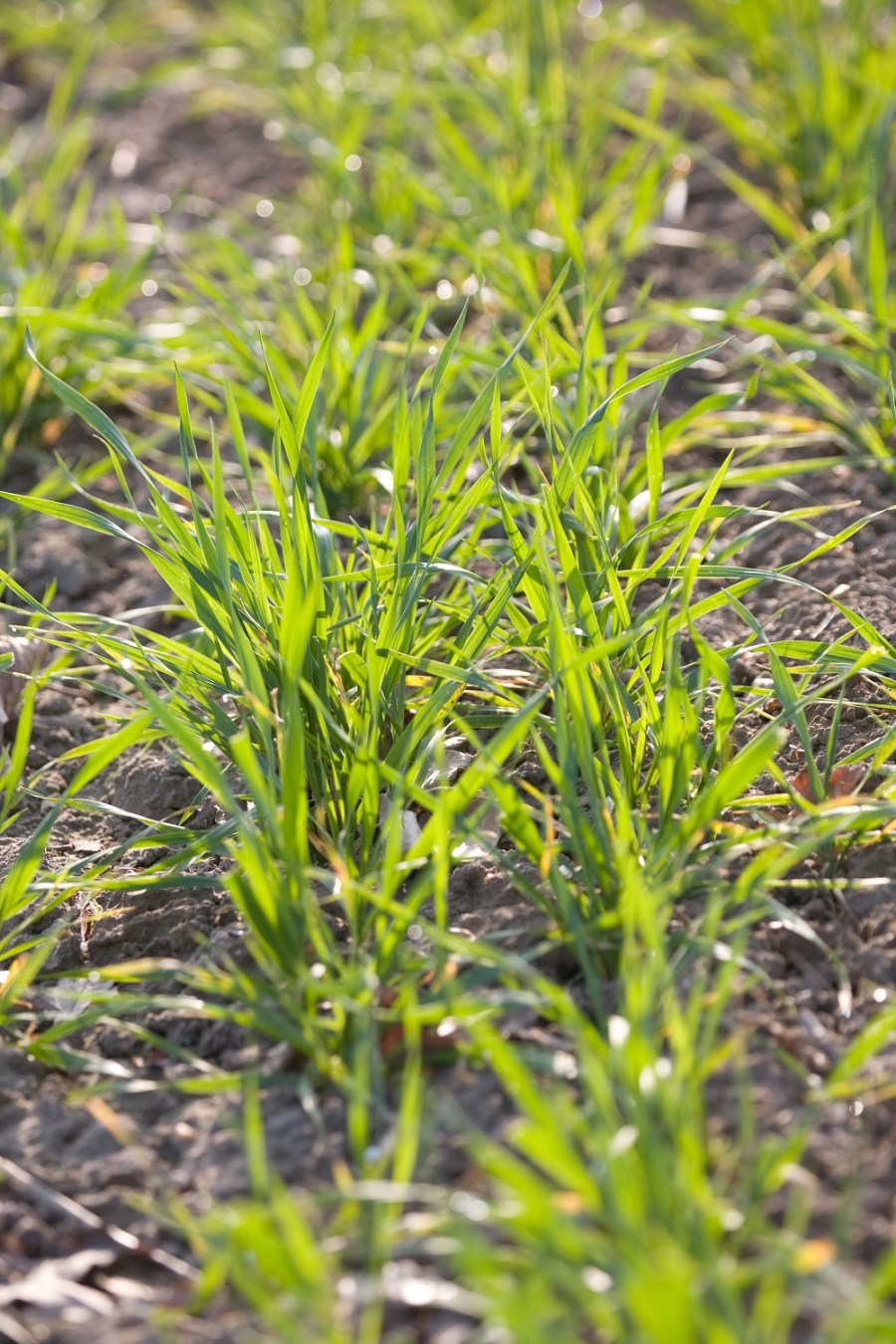With cereal crops well established but at a range of growth stages, early season PGR use has a crucial role in ensuring they reach their potential. CPM summarises recent UK research that’s focused in this area.
We know there’s a benefit from applying Moddus at T0. What we wanted to understand was why.
By Tom Allen-Stevens
Good autumn conditions last year and a relatively kind winter have produced cereal crops packed with potential, according to early field reports. But delivering this will require careful early season management, says Syngenta field technical manager James Southgate.
“Generally, there are two stages of wheat crops coming out of the winter,” he explains. “Those drilled in Sept or Oct are now quite large, while there are crops that were drilled later, especially in fields where blackgrass is a problem. These have established well, but are much thinner and lag behind in terms of growth stage.”
Adapting early season management to crop growth will give growers the best chance of maximising the biomass a crop puts on. According to Dr Daniel Kindred of ADAS, results from the Yield Enhancement Network (YEN) initiative have shown there’s a strong association between final crop biomass and yield. “Having a strong root system after winter and sufficient shoot numbers is important in achieving this,” he notes.

Researchers found Moddus increased root length density by 40% at 30cm depth – where advantageous roots are found.
Temperatures this winter have been slightly below those experienced last year, but there’s been less rainfall, leading to fewer water-logged fields. “The net result is that early drilled crops are as big, if not bigger, than they were last year,” reports James Southgate.
“The aim will be to retain their tillers, so they’ll need access early on to nitrogen. But residual N levels are not particularly high following last season’s high summer rainfall, so early N applications may be needed.”
But he sounds a cautionary note over lodging. “The biggest cause of this is root lodging, so if you’re encouraging biomass above ground, make sure your plant has a sufficient root-plate diameter to support this. PGR applied at the T0 timing will help here.
“What’s more, bigger, thicker crops will compete more as the spring progresses, increasing the risk of stem lodging. So a T1 PGR to thicken stems and shorten the length between internodes should be considered.”
Many thinner crops have just started tillering, or could be even further behind, he notes, so there’s a different aim. “A lot of work we’ve done shows that early N applications help so much in bringing these crops on,” continues James Southgate.
Root development
“We want them to grow quickly and tiller to compete with the blackgrass, but it’s essential they also continue to develop their roots. Again, T0 is the right timing to apply a PGR to help the plant balance this early season growth.” Whether it then needs a follow-up T1 PGR will depend on crop growth and variety, he says.
But this emphasis on early season crop management throws up a number of worrying implications, he notes. “For the past couple of seasons, there have been mild autumn and winters, followed by a relatively cold spring, and that’s played havoc with crop growth.
“Crops will sit stagnant for weeks in early spring and then explode into life and there’s a higher risk of long internodes and weaker crops. What’s more, it can be very cold at the T0 timing, and there hasn’t been much scientific scrutiny of uptake of chemistry at this point in the season, particularly as the T0 has taken on a more pivotal role in UK spray programmes.”
Breeding advances have also meant modern varieties tend to have shorter, stiffer straw, although little is known about how their roots develop and whether they are better able to withstand root lodging.
“We identified there was a need to carry out some further research into the uptake of PGR at this crucial, early timing. Syngenta has the facility to do this at Jealotts Hill Research Centre in Berks. It’s a very valuable resource, and while its main focus is to develop new products, there’s unrivalled expertise on hand to investigate specific issues, especially those directly relevant to UK conditions,” notes James Southgate.
Wheat plants were grown in the greenhouse and kept at 7°C. “The 30-year average for April is 7.9°C, but 7°C is what you’d expect at the T0 timing.” These were then treated in a way to mimic field conditions with a full label rate of chlormequat or Moddus. Leaves were then analysed up to 70 hours after application to assess uptake.
“The results are pretty clear,” he points out (see chart on page xx). “After just 15 hours, 70% of the Moddus had been taken up by the treated plants, while it took 55hrs for the same uptake of chlormequat.
“At normal spring temperatures – above 10°C – the difference in uptake is fairly insignificant. But in a prolonged period of cold weather, common at that time of year, you’d want the PGR to be taken up and to start working as early as possible. What’s more, if the product’s hanging around on the leaf surface, it’s more prone to being washed off in a rain shower.”
So James Southgate’s recommendation is to rely on Moddus at 0.2 l/ha at T0, applied across both forward and thinner crops. “The T1 timing is where I’d apply chlormequat, adding in another 0.2 l/ha of Moddus, or cutting this down to 0.1 l/ha in low risk situations.
“Note that high blackgrass populations will increase lodging risk, but you may want to assess at T1 whether it’s worth continuing with the crop or spraying out bad patches with glyphosate, and saving any further input spend,” he concludes.
What does Moddus do?
Moddus contains trinexapac-ethyl, a synthetic plant growth regulator (PGR). It modifies growth by inhibiting the action of a key enzyme used to produce gibberellic acid. This prevents the formation of gibberellins, plant hormones which promote cell elongation. Without gibberellins, the internodes of the plant fail to grow and this leads to shorter, thicker stems.
A side effect of reduced gibberellin biosynthesis is altered levels of other plant hormones. This leads to a shifting of assimilates to the roots which results in increased cytokinin formation. The reduced apical dominance of the main stem leads to greater tiller production during early season plant growth, although Moddus inhibits internodal growth in tillers as well.
The results of these PGR effects include reduced stem and root lodging, delayed senescence and increased resistance to environmental stress. Moddus is also formulated with surfactants and penetrants designed to enhance activity, especially in colder conditions.
Surface tension tests put generics on the slide
Work carried out at Jealotts Hill Research Centre has shown different formulations of trinexapac-ethyl vary considerably in how they stick and spread on a cereal leaf. While Moddus was found to have a high retention, the surfactants in other formulations can be little better than plain water and result in droplets bouncing off a leaf surface, with product going to waste.
“We regularly test Moddus against generic formulations to see how the spray haze behaves as it leaves the sprayer nozzle and arrives on the target leaf. We want to understand the formulation better and make improvements where we can,” explains Syngenta scientist Jean-Charles Broquet.

Surfactant molecules in the water droplets on the left move quickly to the outer surface of the droplets, giving them a low dynamic surface tension (DST), which ensures good leaf retention.
“The main property we’re looking to test is dynamic surface tension (DST) – a low value allows the water droplets to collapse and stay on the leaf. But if DST is too high, the droplets bounce or run off like balls.”
The surfactants in the formulation make all the difference in how the droplets behave. These molecules must move to the outer surface of a droplet before it lands on the leaf to break the surface tension and keep the product from bouncing off (see diagram on page xx). “But the surfactant molecules need to move fast – there’s just 75-100ms between a droplet leaving a nozzle and landing on the leaf,” he points out.
A measuring instrument with a small capillary tube was used in the lab to mimic a sprayer nozzle and the DST of droplets containing nine different products was assessed. “We used standard field dilution rates for all products.”
Moddus was the only product that came in with a DST below 50 mN/m, regarded as the threshold for high leaf retention, reports Jean-Charles Broquet. “Others had adequate retention, but some generics had very disappointing results.”
Spreading ability on the leaf was also measured. “What we’re looking for is a droplet that quickly loses its spherical shape and looks more like a squat dome on the leaf surface, covering as much area as possible,” he explains.
“A low DST suggests a good spreading ability, although a formulation with a high DST can also spread well, given enough time. Moddus performed well here, as did some of the generics. But one or two were very poor at spreading.”
These properties are important for the efficacy of a product, especially early in the season, notes Jean-Charles Broquet. “The target is relatively small, unlike later in the year when a droplet that bounces off a leaf may be captured elsewhere in the crop canopy. And you need the droplet to spread well so that plenty of the product comes into contact with the leaf and can act quickly.”
Comparative efficiency of PGR uptake at cold temperatures

Source: Syngenta Jealott’s Hill Research Centre
Plants treated with PGRs have pulling power
Applying an early season PGR can increase rooting strength by up to six times, according to trials carried out at Syngenta’s Innovation Centres.
“We know there’s a benefit from applying Moddus at T0 as well as at T1 over and above applying it at T1 alone,” notes Syngenta’s head of technical, Dave King. “What we wanted to understand was why.”
Trials carried out in 2016 established a yield benefit from the T0 application of 0.5t/ha on average. “Work carried out by ADAS High Mowthorpe previously looked at root-length density,” he explains.
“By taking cores and measuring the length of roots in each cm3 of soil, researchers found Moddus increased root length density by 40% at 30cm depth – where advantageous roots are found.”
So technicians at the Newark Innovation Centre developed a technique to measure the rooting strength this conferred to the wheat plants. “It was a fairly simple test – we attached fish scales to the base of plants and measured the force required to uproot them,” reports Dave King.
In the untreated plots, a tug of 46.1N was needed to free the roots from the soil. But a treatment of 1 l/ha of chlormequat at both T0 and T1 increased this to 235N. Add in 0.15 l/ha of Moddus at each timing and this increased further to 274N.
“Roots do two jobs – they anchor the plant to the ground, reducing the risk of lodging, and take up water and nutrients for the crop,” notes Dave King. “The more roots a plant has, the more contact it has with the soil and the more efficient it becomes, so it’s more able to withstand challenging conditions. So if you set the crop up well early in the season, you’ve a greater chance of achieving its maximum potential yield.”
Crop resilience against ‘the second landlord’
For Oxon-based independent agronomist Geoff Hawes, cropping and drilling dates these days are largely determined by what he refers to as ‘the second landlord’. “For a lot of my clients, blackgrass has meant a complete restructure,” he says.
“Following the holocaust years of 2012/13, there’s been a switch for a lot of growers into spring barley. Winter barley is almost exclusively hybrid varieties these days, while winter wheats are established much later.”
While conventional barleys don’t tolerate a late drilling date, he’s found hybrids can be drilled as late as the first week of Nov, provided they’re managed carefully in the early spring.
“For years, I’ve been applying a split dose of PGR, putting half on at the T0, or pre-T1 timing. This used to be a half dose of Moddus at the early timing with some chlormequat. But just using Moddus on its own seems to do the job.”
He puts this down to the unreliability of the weather at that time of year. “You’ll often find there’s a cold, dry period and the crop will sit there and do nothing. By the time it wakes up, the crop could be past the point where it wants the PGR. My observation is that crops take up the Moddus at application, but they don’t take up chlormequat unless conditions are right.”
But there’s one thing he’s absolutely convinced about. “With hybrid barley, it’s the integration of the PGR with the nitrogen and the fungicides that sets a crop up to perform. Get it right and you can see the difference later in the season – you get an extended grain-filling period, resulting in higher specific weight. There’s also a stronger rachis – the loop where the ear meets the stem – which means less brackling.”
With wheat, the principle is much the same. “Again, I’d split the dose of Moddus, especially where the crop has been drilled late, so that the early application helps rooting and tillering. Whether it needs a later application depends on variety, crop growth and site fertility.”
There’s also a place for Moddus at an early timing on spring barley, he says. “A 0.2-0.3 l/ha dose at the end of tillering seems to set the crop up better, and results in less leaning at harvest,” says Geoff Hawes.

Research Briefing
To help growers get the best out of technology used in the field, manufacturers continue to invest in R&D at every level, from the lab to extensive field trials. CPM Research Briefings provide not only the findings of recent research, but also an insight into the technology, to ensure a full understanding of how to optimise its use.
CPM would like to thank Syngenta for sponsoring this Research Briefing and for providing privileged access to staff and material used to help bring it together.
Syngenta is committed to the continued R&D of both existing technologies and new products to help farmers get the best from every application and make more efficient use of resources – to grow more from less. Syngenta invests around £1.1bn a year in global agriculture R&D. These advances enable more effective ICM programmes to create profitable and sustainable intensive farming systems, now and in the future.




